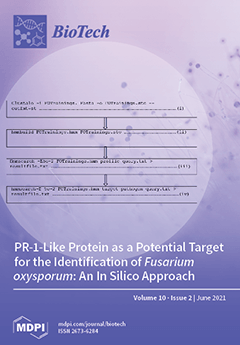Fusarium oxysporum remains one of the leading causes of economic losses and poor crop yields; its detection is strained due to its presentation in various morphological and physiological forms. This research work sought to identify novel biomarkers for the detection of
Fusarium oxysporum using in silico approaches. Experimentally validated anti-
Fusarium oxysporum antimicrobial peptides (AMPs) were used to construct a profile against
Fusarium oxysporum. The performance and physicochemical parameters of these peptides were predicted. The gene for the
Fusarium oxysporum receptor protein PR-1-like Protein, Fpr1, was identified and translated. The resulting protein model from the translation was then validated. The anti-
Fusarium oxysporum AMPs and
Fusarium oxysporum receptor protein 3-D structures were characterized, and their docking interaction analyses were carried out. The HMMER in silico tool identified novel anti-
Fusarium oxysporum antimicrobial peptides with good performance in terms of accuracy, sensitivity, and specificity. These AMPs also displayed good physicochemical properties and bound with greater affinity to
Fusarium oxysporum protein receptor PR-1-like Protein. The tendency of these AMPs to precisely detect
Fusarium oxysporum PR-1-like Protein, Fpr1, would justify their use for the identification of the fungus. This study would enhance and facilitate the identification of
Fusarium oxysporum to reduce problems associated with poor crop yield, economic losses, and decreased nutritional values of plants to keep up with the growing population.
Full article






